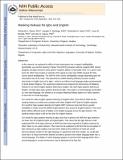| dc.contributor.author | Ebem, Deborah U. | |
| dc.contributor.author | Desloge, Joseph G. | |
| dc.contributor.author | Reed, Charlotte M. | |
| dc.contributor.author | Braida, Louis D. | |
| dc.contributor.author | Uguru, Joy O. | |
| dc.date.accessioned | 2015-11-10T19:10:06Z | |
| dc.date.available | 2015-11-10T19:10:06Z | |
| dc.date.issued | 2013-09 | |
| dc.identifier.issn | 2006-1781 | |
| dc.identifier.uri | http://hdl.handle.net/1721.1/99894 | |
| dc.description.abstract | In this research, we explored the effect of noise interruption rate on speech intelligibility. Specifically, we used the Hearing In Noise Test (HINT) procedure with the original HINT stimuli (English) and Igbo stimuli to assess speech reception ability in interrupted noise. For a given noise level, the HINT test provides an estimate of the signal-to-noise ratio (SNR) required for 50%-correct speech intelligibility. The SNR for 50%-correct intelligibility changes depending upon the interruption rate of the noise. This phenomenon (called Masking Release) has been studied extensively in English but not for Igbo – which is an African tonal language spoken predominantly in South Eastern Nigeria. This experiment explored and compared the phenomenon of Masking Release for (i) native English speakers listening to English, (ii) native Igbo speakers listening to English, and (iii) native Igbo speakers listening to Igbo. Since Igbo is a tonal language and English is a non-tonal language, this allowed us to compare Masking Release patterns on native speakers of tonal and non-tonal languages. Our results for native English speakers listening to English HINT show that the SNR and the masking release are orderly and consistent with other English HINT data for English speakers. Our result for Igbo speakers listening to English HINT sentences show that there is greater variability in results across the different Igbo listeners than across the English listeners. This result likely reflects different levels of ability in the English language across the Igbo listeners. The masking release values in dB are less than for English listeners. Our results for Igbo speakers listening to Igbo show that in general, the SNRs for Igbo sentences are lower than for English/English and Igbo/English. This means that the Igbo listeners could understand 50% of the Igbo sentences at SNRs less than those required for English sentences by either native or non-native listeners. This result can be explained by the fact that the perception of Igbo utterances by Igbo subjects may have been aided by the prediction of tonal and vowel harmony features existent in the Igbo language. In agreement with other studies, our results also show that in a noisy environment listeners are able to perceive their native language better than a second language. The ability of native language speakers to perceive their language better than a second language in a noisy environment may be attributed to the fact that:
a) Native speakers are more familiar with the sounds of their language than second language speakers.
b) One of the features of language is that it is predictable hence even in noise a native speaker may be able to predict a succeeding word that is scarcely audible. These contextual effects are facilitated by familiarity. | en_US |
| dc.description.sponsorship | National Institutes of Health (U.S.) (Grant R01 DC00117) | en_US |
| dc.language.iso | en_US | |
| dc.publisher | Institute of Electrical and Electronics Engineers (IEEE) | en_US |
| dc.relation.isversionof | http://www.ajocict.net/vol_6_no_3_september_2013.html | en_US |
| dc.rights | Creative Commons Attribution-Noncommercial-Share Alike | en_US |
| dc.rights.uri | http://creativecommons.org/licenses/by-nc-sa/4.0/ | en_US |
| dc.source | PMC | en_US |
| dc.title | Masking Release for Igbo and English | en_US |
| dc.type | Article | en_US |
| dc.identifier.citation | Ebem, D. U., J. G. Desloge, C. M. Reed, L. D. Braida, and J. O. Oguru. "Masking Release for Igbo and English." African Journal of Computing & ICT 6(3) (September 2013): 119-126. | en_US |
| dc.contributor.department | Massachusetts Institute of Technology. Department of Electrical Engineering and Computer Science | en_US |
| dc.contributor.department | Massachusetts Institute of Technology. Research Laboratory of Electronics | en_US |
| dc.contributor.mitauthor | Desloge, Joseph G. | en_US |
| dc.contributor.mitauthor | Reed, Charlotte M. | en_US |
| dc.contributor.mitauthor | Braida, Louis D. | en_US |
| dc.relation.journal | African Journal of Computing & ICT | en_US |
| dc.eprint.version | Author's final manuscript | en_US |
| dc.type.uri | http://purl.org/eprint/type/JournalArticle | en_US |
| eprint.status | http://purl.org/eprint/status/PeerReviewed | en_US |
| dspace.orderedauthors | Ebem, D. U.; Desloge, J. G.; Reed, C. M.; Braida, L. D.; Oguru, J. O. | en_US |
| dc.identifier.orcid | https://orcid.org/0000-0003-1680-1913 | |
| dc.identifier.orcid | https://orcid.org/0000-0002-8431-4730 | |
| dc.identifier.orcid | https://orcid.org/0000-0003-2538-9991 | |
| mit.license | OPEN_ACCESS_POLICY | en_US |
| mit.metadata.status | Complete | |
